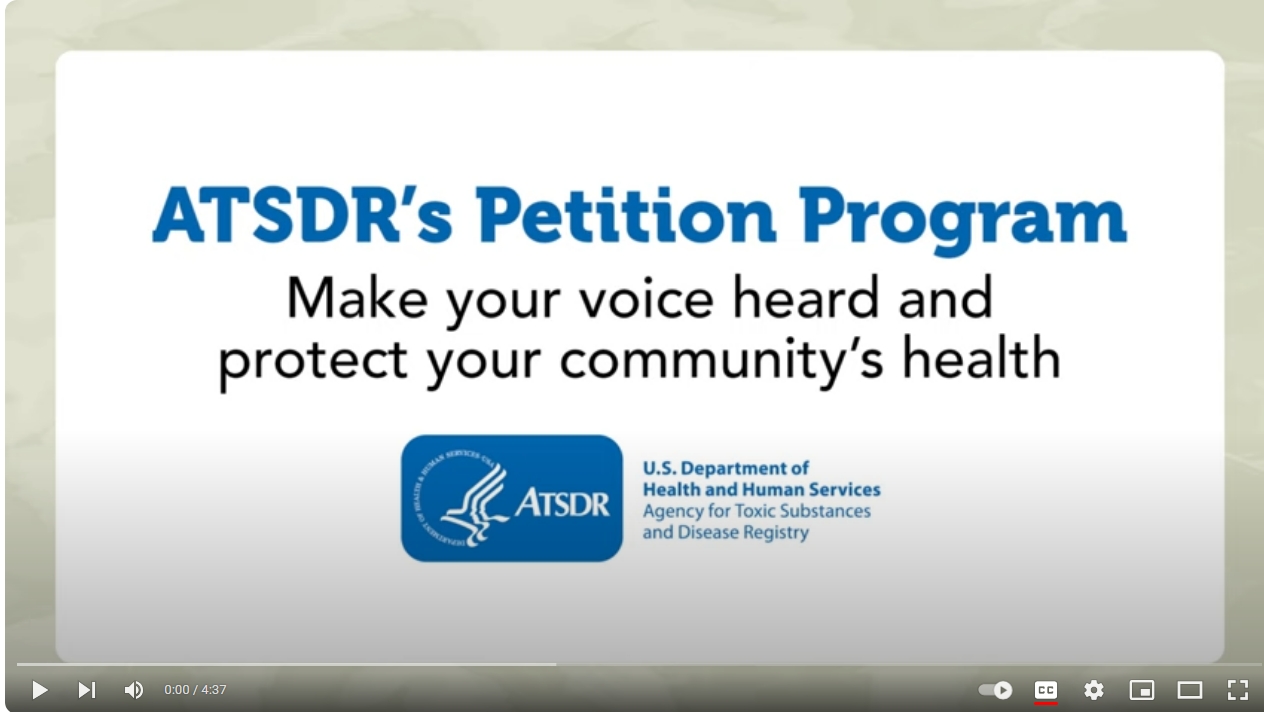What to know
- Sometimes toxic substances get into the water, soil, or air in our environment — and that can lead to health concerns.
- If you are worried about an environmental issue in your community, you can ask ATSDR to look into the issue by submitting a petition.

Submitting a Petition
A petition is a written request asking ATSDR to investigate specific environmental health concerns in a community. Any person or community organization can submit a petition. You do not need anyone else to sign your petition to submit it to ATSDR.
How to Submit a Petition
Please email your petition to ATSDRPetitions@cdc.gov. Be sure to include the following information:
- Your name
- The name of your community organization (if you're part of an organization)
- A description of the issue you're concerned about
- Your contact information (email address, phone number, or mailing address)
What to Expect After Submitting a Petition
After you submit a petition, ATSDR will carefully review your request and decide on next steps. Here's what to expect:
ATSDR's petition review process
ATSDR will review your petition and gather information about the environmental concern. As part of this process, ATSDR will do the following:
- First, we will review existing information and environmental data about your concern.
- Next, we will check to see if other people have made complaints to other environmental and public health agencies about the concern.
- Then, we will determine if enough information is available to investigate and evaluate your concern. If the available information indicates potential exposures of concern, and if not, what further information may be needed.
This review process usually takes about 6 to 12 months. Then, ATSDR will let you know if your petition is accepted or denied.
What happens if your petition is accepted
If ATSDR accepts your petition, we will conduct public health activities to learn more about the issue. ATSDR scientists will do the following:
- First, we determine if there has been exposure to a hazardous substance and if this exposure could affect your health.
- We will offer recommendations on how you can reduce, stop, or prevent exposure to the substance.
- We also inform and involve your community in our findings and other activities to help address their concern.
ATSDR may work with your state, local, and territorial health departments and community organizations to address your concerns.
What happens if your petition is not accepted
If ATSDR is not able to accept your petition, ATSDR will not be conducting public health activities in response to your request. However, depending on the situation, ATSDR may be able to help your community in other ways.
If your petition is not accepted, we will tell you why. For example, a petition may be denied for the following reasons:
- ATSDR has already addressed the environmental issue.
- We determined that there is not enough information to evaluate the potential environmental exposure and health concern.
- Community members are unlikely to come into contact with harmful substances at levels of concern because of the issue.
What ATSDR can (and cannot) do
After assessing the environmental health issue, ATSDR may recommend steps community members, organizations, and agencies can take to prevent possible health risks and to protect the health of your community.
ATSDR is not a regulatory agency. This means ATSDR cannot clean up chemicals or direct facilities to change how they operate. ATSDR also cannot diagnose health conditions or tell you if the environmental health concern is connected to health problems that community members are experiencing.
Contact ATSDR with questions
If you have questions about submitting a petition, call ATSDR toll-free at 1-800-232-4636. For TTY, call 1-888-232-6348. Ask to be connected to your ATSDR regional office.

